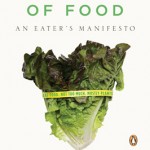Inside The New York Botanical Garden
Plant Talk
Posted in Exhibitions, Shop/Book Reviews, The Edible Garden on June 24 2009, by Plant Talk
 John Suskewich is Book Manager for Shop in the Garden.
John Suskewich is Book Manager for Shop in the Garden.
With apologies to Cicero but with respect to American eating habits: O tempura! O morels!
The Western diet—based on fats, processed foods and convenience foods, and industrialized agriculture—may be responsible for a host of ills. In the last hundred years or so, it “has changed in ways that are making us increasingly sick and fat,” one food journalist recently commented. Ever more frequently and from many quarters, it is being questioned, rethought, reinvented. So it is that The Edible Garden, the Botanical Garden’s summer-long celebration of growing, preparing, and eating great food, comes at a propitious moment. With the current debate and state of eating in the United States, what do our on-site exhibitions bring to the table? Here are a few sources for perspective on this issue.
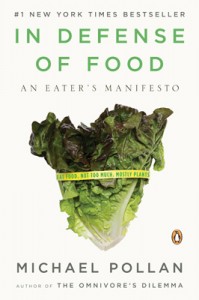 Journalist/gardener Michael Pollan is one of the pioneers in sounding the alarm about the American diet. His most recent book, In Defense of Food, argues thoroughly, convincingly, and very readably that good health will come when we reject the current reliance on fast food, food substitutes, food byproducts, engineered food, overpackaged food, overprocessed food, or any comestible with an adjective attached. His manifesto is very close to the mission of this institution—to be an advocate for the plant kingdom—and it boils down to: “Eat food. Not too much. Mostly plants.”
Journalist/gardener Michael Pollan is one of the pioneers in sounding the alarm about the American diet. His most recent book, In Defense of Food, argues thoroughly, convincingly, and very readably that good health will come when we reject the current reliance on fast food, food substitutes, food byproducts, engineered food, overpackaged food, overprocessed food, or any comestible with an adjective attached. His manifesto is very close to the mission of this institution—to be an advocate for the plant kingdom—and it boils down to: “Eat food. Not too much. Mostly plants.”
 What to Eat by Marion Nestle takes this advice and turns it into a field guide for the supermarket. What is fresh, organic, low fat, reduced fat, no fat, trans fat, polyunsaturated fat, fat free?? For the consumer trying to “do the right thing,” the grocery chain is ground zero in the food chain, but it is a mine field, with marketing, packaging, and processing tripwires that can land you with eggbeaters all over your face. What to Eat analyzes the claims, counterclaims, labels, small print, jargon, subtext, and easy-open cartons to uncover the real truth about the dairy case and the frozen food aisle to make shoppers more savvy.
What to Eat by Marion Nestle takes this advice and turns it into a field guide for the supermarket. What is fresh, organic, low fat, reduced fat, no fat, trans fat, polyunsaturated fat, fat free?? For the consumer trying to “do the right thing,” the grocery chain is ground zero in the food chain, but it is a mine field, with marketing, packaging, and processing tripwires that can land you with eggbeaters all over your face. What to Eat analyzes the claims, counterclaims, labels, small print, jargon, subtext, and easy-open cartons to uncover the real truth about the dairy case and the frozen food aisle to make shoppers more savvy.
Read More
Posted in People, Science on June 23 2009, by Plant Talk
Garden Scientist Participates in the Venice Biennale
 |
Ina Vandebroek, Ph.D., is a Research Associate and Project Director of Dominican Traditional Medicine for Urban Community Health with the Botanical Garden’s Institute of Economic Botany. Photo of Ina by Bert de Leenheer |
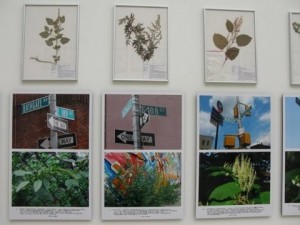 Every two years, Venice turns into the Cannes of the art world for La Biennale di Venezia: an international festival of art—with a capital “A.” From June to November, this city that always counts more visitors than residents becomes the scene for everything and everyone involved in the arts: curators, art critics, collectors, art aficionados, and, of course, the artists themselves. This year I participated as an ethnobotanist who collaborated with the Belgian contemporary artist Jef Geys for the 53rd Biennale, called Fare Mundi (Making Worlds).
Every two years, Venice turns into the Cannes of the art world for La Biennale di Venezia: an international festival of art—with a capital “A.” From June to November, this city that always counts more visitors than residents becomes the scene for everything and everyone involved in the arts: curators, art critics, collectors, art aficionados, and, of course, the artists themselves. This year I participated as an ethnobotanist who collaborated with the Belgian contemporary artist Jef Geys for the 53rd Biennale, called Fare Mundi (Making Worlds).
You might wonder what an ethnobotanist has to do with art? I usually spend most of my days in the field with my nose stuck in plants, collecting them to make botanical specimens and identify their Latin names. Or, I conduct interviews with people to find out how these plants are used by local cultures, such as in traditional medicines. But now I found myself flying to the city of gondolas and vaporettos (water taxis) to assist in the inauguration of the Belgian pavilion where the installation from Jef Geys is on display.
When I was 13 years old and still living in Belgium, Jef was my art teacher. I remember making conventional drawings in art class, but Jef was by no means a conventional art teacher. He likes to challenge his surroundings and the people in it, and by doing so subtly makes them change their perceptions about art and life. He offers no lessons; instead, the experience itself is the lesson. Now, so many years later, I relived that experience when Jef asked me to apply the methods I had acquired during my training as an ethnobotanist at The New York Botanical Garden to “go out in the urban fields of New York City and collect 12 plants growing in the streets of my home in the Bronx that could be used as medicines by homeless people.” Jef asked other acquaintances from the art world who live in Moscow, Brussels, and Villeurbanne (France) to do the same thing and guided them with the methodology.
Read More
Posted in Uncategorized on June 19 2009, by Plant Talk
…and a Farewell to Spring
 |
Jessica Blohm is Interpretive Specialist for Public Education. |
Tomorrow marks the longest day of the year, the day when the sun is farthest north in the sky and we have the greatest number of daylight hours. Also known as the Summer Solstice, this day marks the end of spring and the beginning of summer. We are eager for warmer and drier days, but before we turn the page, let’s reflect on what an amazing spring it has been here at the Garden.
From exhibitions such as The Glory of Dutch Bulbs: A Legacy of 400 Years to the magnificent spectacle of flowering trees and perennials across the grounds, spring has been truly unique. And none of these extensive, glorious displays and exhibitions would be possible without the dedication of the Arboretum and Grounds crew and Outdoor Gardens staff.
So we say thank you to all for their good work, whether it be planting, trimming, placing sod, arranging planters, or transferring soil. Here we show you some behind-the-scenes images of what helped make the spring displays so remarkable.
Check out all of Saturday’s programming
Check out all of Sunday’s programming
Posted in Programs and Events on June 18 2009, by Plant Talk
Excitement Builds Working with Star Chefs for The Edible Garden
 Jennifer Rothman is Associate Vice President of Children’s and Public Education.
Jennifer Rothman is Associate Vice President of Children’s and Public Education.
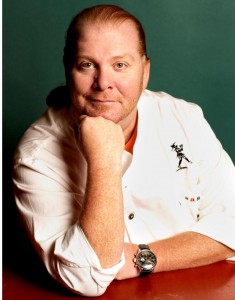 When the idea for The Edible Garden—our summer-long celebration of growing great food that begins June 27—began floating around, to say I was excited about the prospect of planning such an event is an understatement. You see, I am a bit of a foodie. When I’m not at work, I spend a lot of time thinking about food, cooking food, talking about food, reading about food…you get the picture. Now, after months of organizing this spectacular show, when I stand back and look at the lineup of celebrity chefs and gardeners who are featured, I keep thinking that if I didn’t work here, I would be the first person on line for tickets.
When the idea for The Edible Garden—our summer-long celebration of growing great food that begins June 27—began floating around, to say I was excited about the prospect of planning such an event is an understatement. You see, I am a bit of a foodie. When I’m not at work, I spend a lot of time thinking about food, cooking food, talking about food, reading about food…you get the picture. Now, after months of organizing this spectacular show, when I stand back and look at the lineup of celebrity chefs and gardeners who are featured, I keep thinking that if I didn’t work here, I would be the first person on line for tickets.
I mean, the chefs that are participating are “first-name famous”—Mario, Lidia, Martha—and at the top in their field. My Food Network favorites such as Daisy Martinez and Aida Mollenkamp are coming, too, as are the preeminent chefs of the local food movement like Dan Barber, who was just named James Beard Chef of the Year, and Peter Hoffman, a founding father of the movement.
Just last week I had the pleasure of being in the recording studio with Mario Batali while he recorded the narrations for our Edible Audio Tour. He was such a pro, finishing in less than an hour, and he couldn’t have been nicer. He told me that he and his family were big fans of The New York Botanical Garden and that they were excited to come visit this summer.
Read More
Posted in Programs and Events on June 17 2009, by Plant Talk
Shop Each Wednesday and Now Saturdays, Too
 Gayle Schmidt is Manager of Public Education.
Gayle Schmidt is Manager of Public Education.
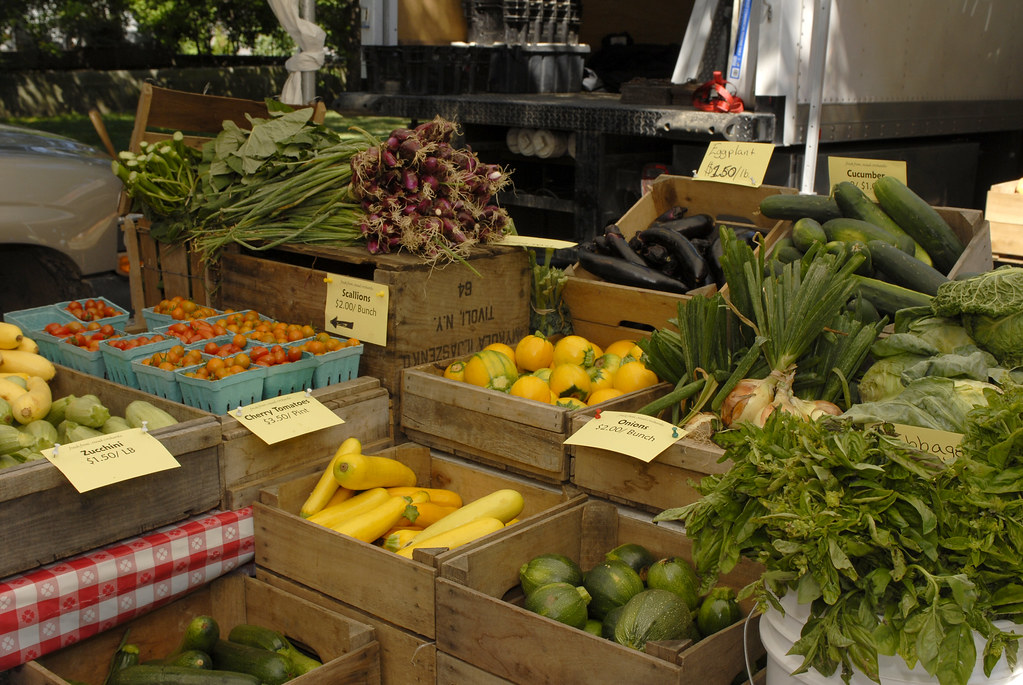 For weeks I haven’t been able to walk down the hallway without someone stopping me to ask, “When does the Farmers Market start?” Everyone at the Garden loves the season when we can purchase farm fresh goods at lunch hour and spend the rest of the afternoon planning recipes for dinner (well, in theory at least). Finally, I can let them know that the time is now—and that the Farmers Market is bigger and better than ever. We have expanded the Market to include Saturdays as well as Wednesdays, we have lengthened the daily hours, and we have increased the offerings to include meats and cheeses along with the colorful array of fruits, vegetables, honey, breads, and baked goods.
For weeks I haven’t been able to walk down the hallway without someone stopping me to ask, “When does the Farmers Market start?” Everyone at the Garden loves the season when we can purchase farm fresh goods at lunch hour and spend the rest of the afternoon planning recipes for dinner (well, in theory at least). Finally, I can let them know that the time is now—and that the Farmers Market is bigger and better than ever. We have expanded the Market to include Saturdays as well as Wednesdays, we have lengthened the daily hours, and we have increased the offerings to include meats and cheeses along with the colorful array of fruits, vegetables, honey, breads, and baked goods.
Farmers markets are a great way to learn more about where your food comes from and how delicious it can be when it has been picked within a day of your purchase. Greenmarket, part of the Council on the Environment of New York City and the largest open-air farmers market program in the country, has coordinated farmers and vendors since 1976 and maintains vigorous standards for sustainable farming and production. There are over 45 Greenmarket farmers markets throughout the City, and now the Botanical Garden’s can be counted among them.
Read More
Posted in Learning Experiences on June 16 2009, by Plant Talk
 |
Peter Couchman is a second-year student in the School of Professional Horticulture. He is doing his required six-month internship at the five-acre Sands Light estate, home to the Sands Point Lighthouse in Port Washington on the north shore of Long Island. The School’s internship program is designed to allow students to synthesize and apply what they’ve learned, expand their skills by providing further training in a professional horticulture venue, and expose them to the multiple facets of the field. Peter sent us this report.
|
One condition of my accepting this internship was to introduce a composting program: Prior to my arrival, there was no composting on the estate. All garden waste was placed in the municipal garbage.
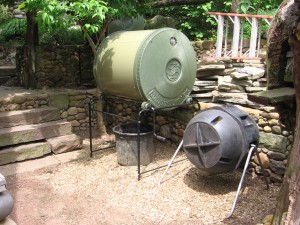 Since my time here, I’m happy to say, I have researched, installed, and implemented a composting facility. With limited space for a compost area, it was important that the facility not be unsightly as it would be close to the house. For that reason, I chose to use compost tumblers, which keep the compost out of sight and are easy to turn and oxygenate. They also keep out wild animals such as the ever-present raccoons. To facilitate the composting process, I established a new wood-chipping area to create a good carbon source of sawdust and woodchips. The main nitrogen source comes from the collected clippings from each week’s lawn mowing. Recently, I began collecting kitchen waste such as eggshells and vegetable and fruit scraps for composting as well. Through composting, we have decreased the amount of waste we place in the municipal garbage by up to 30 percent.
Since my time here, I’m happy to say, I have researched, installed, and implemented a composting facility. With limited space for a compost area, it was important that the facility not be unsightly as it would be close to the house. For that reason, I chose to use compost tumblers, which keep the compost out of sight and are easy to turn and oxygenate. They also keep out wild animals such as the ever-present raccoons. To facilitate the composting process, I established a new wood-chipping area to create a good carbon source of sawdust and woodchips. The main nitrogen source comes from the collected clippings from each week’s lawn mowing. Recently, I began collecting kitchen waste such as eggshells and vegetable and fruit scraps for composting as well. Through composting, we have decreased the amount of waste we place in the municipal garbage by up to 30 percent.
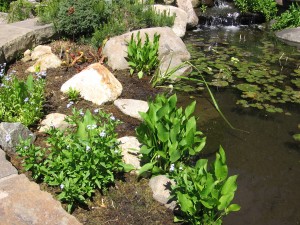 In addition, I designed and installed a new bog garden within an existing pond and waterfall feature. I was able to incorporate Sarracenia leucophylla ‘Tarnok’, Sarracenia purpurea, Iris fulva, Mimulus sp., Pinguicula primuliflora, and other Pinguicula species that the owner already had. We will be adding additional carnivorous and bog plants in the next couple of weeks.
In addition, I designed and installed a new bog garden within an existing pond and waterfall feature. I was able to incorporate Sarracenia leucophylla ‘Tarnok’, Sarracenia purpurea, Iris fulva, Mimulus sp., Pinguicula primuliflora, and other Pinguicula species that the owner already had. We will be adding additional carnivorous and bog plants in the next couple of weeks.
Read More
Posted in Programs and Events on June 12 2009, by Plant Talk
 Gayle Schmidt is Manager of Public Education.
Gayle Schmidt is Manager of Public Education.
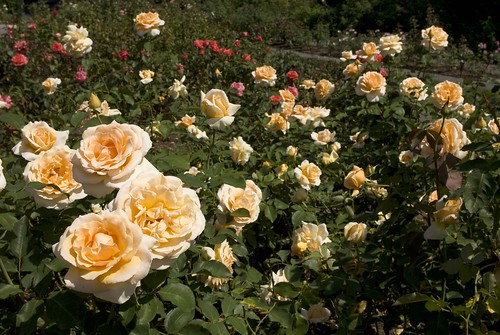 Wine and roses—what a romantic combination! Evening events at the Garden are among my favorite to organize. Even when I’m setting up and readying for the arrival of guests, the work is more relaxed and enjoyable. It is a different kind of busy than being in the office, because once the evening starts, I can enjoy it, too. The lengthening days allow us to be outdoors longer in June. The sun casts long streaks on the grass through the trees and a bright spotlight on the flowers and shrubs as it lowers in the sky. It is time to slow down and take in the day. It is so nice to make this peaceful time in the Garden available to our visitors as well.
Wine and roses—what a romantic combination! Evening events at the Garden are among my favorite to organize. Even when I’m setting up and readying for the arrival of guests, the work is more relaxed and enjoyable. It is a different kind of busy than being in the office, because once the evening starts, I can enjoy it, too. The lengthening days allow us to be outdoors longer in June. The sun casts long streaks on the grass through the trees and a bright spotlight on the flowers and shrubs as it lowers in the sky. It is time to slow down and take in the day. It is so nice to make this peaceful time in the Garden available to our visitors as well.
Following the success of our Kiku and Cocktails evening events this past fall, this month we are highlighting the first blooms of roses at the start of their long season with Wine and Roses evenings. You can kick off your weekend with a stroll among the hundreds of plants in the Peggy Rockefeller Rose Garden and succumb to the lure of these beautiful, scent-filled flowers as many have throughout the ages. Speak with the Curator, Peter Kukielski, and the rose gardeners themselves and learn about the different rose varieties, the new disease-resistant additions, and how the collection is cared for.
As you amble the paths, listen in the background for the live jazz, folk, or contemporary music dancing in the breeze and the gentle clinking of wine glasses celebrating the end of the week, the start of the summer, or the good company of friends. Why not spend an evening at the Garden? A great night for impressing a date, if I say so myself!
Check out all of Saturday’s programming
Check out all of Sunday’s programming
Posted in NYBG in the News, Science, Shop/Book Reviews on June 11 2009, by Plant Talk
 |
Stephen Sinon is Head of Information Services and Archives in The New York Botanical Garden’s LuEsther T. Mertz Library. |
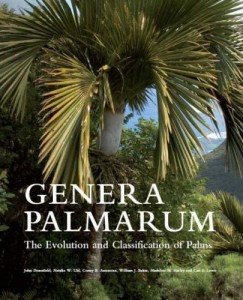 The Council on Botanical and Horticultural Libraries (CBHL), of which NYBG is a founding member, recently presented its 10th Annual Literature Awards. The awards, created to recognize significant contributions to the literature of botany and horticulture, honored three exceptional books this year, all of which acknowledge input from The New York Botanical Garden and all of which can be found in the LuEsther T. Mertz Library. The council is the leading professional organization in the field of botanical and horticultural information services.
The Council on Botanical and Horticultural Libraries (CBHL), of which NYBG is a founding member, recently presented its 10th Annual Literature Awards. The awards, created to recognize significant contributions to the literature of botany and horticulture, honored three exceptional books this year, all of which acknowledge input from The New York Botanical Garden and all of which can be found in the LuEsther T. Mertz Library. The council is the leading professional organization in the field of botanical and horticultural information services.
The General Interest category was topped by Fruits and Plains: The Horticultural Transformation of America, by Philip J. Pauly. (This title is available at Shop in the Garden.) Genera Palmarum: the Evolution and Classification of Palms, by John Dransfield, Natalie W. Uhl, Conny B. Asmussen, William J. Baker, Madeline M. Harley, and Carl E. Lewis, won the Technical category.
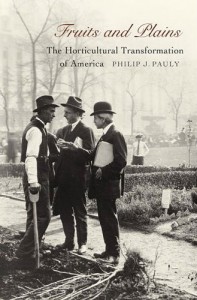 In celebration of the 10th anniversary of the awards, a Special Recognition Award was presented to TL-2, more formally known as Taxonomic Literature: a Selective Guide to Botanical Publications and Collections with Dates, Commentaries and Types, 2nd edition. This monumental work, the first edition of which was compiled by Frans A. Stafleu and Richard S. Cowan as a seven-volume set completed in 1988, is one of the most important resources in botanical literature. The current edition was updated by Laurence J. Dorr, Erik A. Mennega, and Dan H. Nicolson and was honored by CBHL for significant contributions to the literature of botany and the study of plants.
In celebration of the 10th anniversary of the awards, a Special Recognition Award was presented to TL-2, more formally known as Taxonomic Literature: a Selective Guide to Botanical Publications and Collections with Dates, Commentaries and Types, 2nd edition. This monumental work, the first edition of which was compiled by Frans A. Stafleu and Richard S. Cowan as a seven-volume set completed in 1988, is one of the most important resources in botanical literature. The current edition was updated by Laurence J. Dorr, Erik A. Mennega, and Dan H. Nicolson and was honored by CBHL for significant contributions to the literature of botany and the study of plants.
In compiling the massive 15-volume reference work, the authors of Taxonomic Literature used the collections of the Mertz Library; now, over 800 linear feet of their original research papers are in the Library’s archives. The CBHL award was given in recognition of the release of the final volume in this set.
TL-2 acknowledges the outstanding collections of the Mertz Library as well as the assistance provided by the staff, as does Fruits and Plains, whose author also consulted the collection several times while working on his book. The third work, Genera Palmarum, acknowledges the valuable input of two New York Botanical Garden Science staff members: palm expert and Institute of Systematic Botany curator Andrew Henderson, Ph.D., and postdoctoral research associate Thomas Couvreur, Ph.D.
Posted in Uncategorized on June 10 2009, by Plant Talk
 Gregory Long is President and CEO of The New York Botanical Garden.
Gregory Long is President and CEO of The New York Botanical Garden.
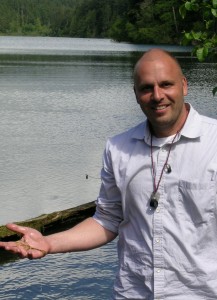 A couple of weeks ago, I had a quintessential New York Botanical Garden day, and I want you to hear about it, as it tells a wonderful story about the people, programs, and collections of this remarkable place.
A couple of weeks ago, I had a quintessential New York Botanical Garden day, and I want you to hear about it, as it tells a wonderful story about the people, programs, and collections of this remarkable place.
It began in the conference room of our Plant Research Laboratory with a scientist new to the Garden, Ken Karol (right), presenting a short lecture on our current research into the Tree of Life—the evolution of plants from green algae up to flowering plants. As you may know, here at the Botanical Garden we are substantially revising scientific thought about evolution because of the research and work conducted in our Cullman Program for Molecular Systematics.
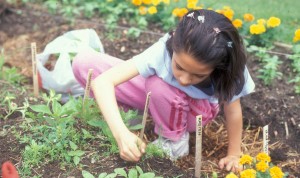 Later that morning I spent some time in our beautiful Howell Family Garden watching a few volunteers and two groups of Bronx second-graders—children maybe 7 or 8 years old—planting lettuce seedlings in fertile, black composty beds that the kids had learned how to prepare. Afterward I saw those same kids marching behind their teachers to go over to tour the Haupt Conservatory to see the plants of the world and a spectacular flower show.
Later that morning I spent some time in our beautiful Howell Family Garden watching a few volunteers and two groups of Bronx second-graders—children maybe 7 or 8 years old—planting lettuce seedlings in fertile, black composty beds that the kids had learned how to prepare. Afterward I saw those same kids marching behind their teachers to go over to tour the Haupt Conservatory to see the plants of the world and a spectacular flower show.
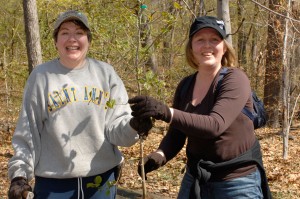 Then my friend (and Board Member) Tom Hubbard came for a visit, and we went with our Forest Manager, Jessica Arcate, into the Garden’s first-growth Forest to visit a site where many very fit volunteers, including Florence Davis of The Starr Foundation (near right with Joanna Baginski) and Board Member Julie Sakellariadis, were planting hundreds of trees to reforest the Forest. It was an inspiring scene.
Then my friend (and Board Member) Tom Hubbard came for a visit, and we went with our Forest Manager, Jessica Arcate, into the Garden’s first-growth Forest to visit a site where many very fit volunteers, including Florence Davis of The Starr Foundation (near right with Joanna Baginski) and Board Member Julie Sakellariadis, were planting hundreds of trees to reforest the Forest. It was an inspiring scene.
 To top it all off, later in the day I was in the Mertz Library, where I met two of our new graduate students and saw a research librarian with a class of our Botanical Art students in the Rare Book Room studying sumptuous 18th-century illustrated plant books.
To top it all off, later in the day I was in the Mertz Library, where I met two of our new graduate students and saw a research librarian with a class of our Botanical Art students in the Rare Book Room studying sumptuous 18th-century illustrated plant books.
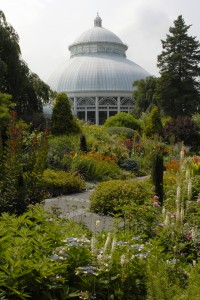 These vignettes are snapshots of the life of the Garden—what’s amazing here is the combination of art and nature, fun and learning, science and conservation, and high intellectual endeavor set in this beautifully planted and maintained sanctuary that we share with millions of people—from graduate students to 7-year-olds.
These vignettes are snapshots of the life of the Garden—what’s amazing here is the combination of art and nature, fun and learning, science and conservation, and high intellectual endeavor set in this beautifully planted and maintained sanctuary that we share with millions of people—from graduate students to 7-year-olds.
Many generations of scientists, horticulturists, educators, administrators, architects, garden designers, and Board Members have labored in a long and sustained effort—since the 1890s—to design and improve; to plant, write, teach; and to make the Garden beautiful and significant. We are privileged to be the contemporary generation fitting into this long continuum.
Posted in Learning Experiences on June 9 2009, by Plant Talk
Monet’s Garden Exposes Subtleties of Color and Light
 |
Christopher Bale is a second-year student in the School of Professional Horticulture. He is doing his required six-month internship at the famous garden at Fondation Claude Monet in Giverny, France, and sent us this report. The School’s internship program is designed to allow students to synthesize and apply what they’ve learned, expand their skills by providing further training in a professional horticulture venue, and expose them to the multiple facets of the field.
|
At the Fondation Claude Monet garden in Giverny, France, I am learning a number of new skills that will serve me in my horticulture career. It is spring, and I am learning about different approaches to spring plantings as well as preparation for summer plantings.
The amazing things about the Monet garden are the subtleties and approaches to the use of color and light. These ideas are reflected in the various areas of the garden and are the design approaches that are the most important aspect of my learning experience.
Daily I am involved in all aspects of horticultural maintenance: pruning, planting, deadheading, and plant production. The new skills I have learned pertain to the day-to-day approaches to management and planning for a garden of this size and stature. I have learned many new plants along with many French common names. Most important has been the strengthening of my knowledge of the distinctions between the Narcissus divisions of the family Amaryllidaceae and the Tulipa types of the Liliaceae.
 John Suskewich is Book Manager for Shop in the Garden.
John Suskewich is Book Manager for Shop in the Garden. Journalist/gardener Michael Pollan is one of the pioneers in sounding the alarm about the American diet. His most recent book, In Defense of Food, argues thoroughly, convincingly, and very readably that good health will come when we reject the current reliance on fast food, food substitutes, food byproducts, engineered food, overpackaged food, overprocessed food, or any comestible with an adjective attached. His manifesto is very close to the mission of this institution—to be an advocate for the plant kingdom—and it boils down to: “Eat food. Not too much. Mostly plants.”
Journalist/gardener Michael Pollan is one of the pioneers in sounding the alarm about the American diet. His most recent book, In Defense of Food, argues thoroughly, convincingly, and very readably that good health will come when we reject the current reliance on fast food, food substitutes, food byproducts, engineered food, overpackaged food, overprocessed food, or any comestible with an adjective attached. His manifesto is very close to the mission of this institution—to be an advocate for the plant kingdom—and it boils down to: “Eat food. Not too much. Mostly plants.” What to Eat by Marion Nestle takes this advice and turns it into a field guide for the supermarket. What is fresh, organic, low fat, reduced fat, no fat, trans fat, polyunsaturated fat, fat free?? For the consumer trying to “do the right thing,” the grocery chain is ground zero in the food chain, but it is a mine field, with marketing, packaging, and processing tripwires that can land you with eggbeaters all over your face. What to Eat analyzes the claims, counterclaims, labels, small print, jargon, subtext, and easy-open cartons to uncover the real truth about the dairy case and the frozen food aisle to make shoppers more savvy.
What to Eat by Marion Nestle takes this advice and turns it into a field guide for the supermarket. What is fresh, organic, low fat, reduced fat, no fat, trans fat, polyunsaturated fat, fat free?? For the consumer trying to “do the right thing,” the grocery chain is ground zero in the food chain, but it is a mine field, with marketing, packaging, and processing tripwires that can land you with eggbeaters all over your face. What to Eat analyzes the claims, counterclaims, labels, small print, jargon, subtext, and easy-open cartons to uncover the real truth about the dairy case and the frozen food aisle to make shoppers more savvy. 



